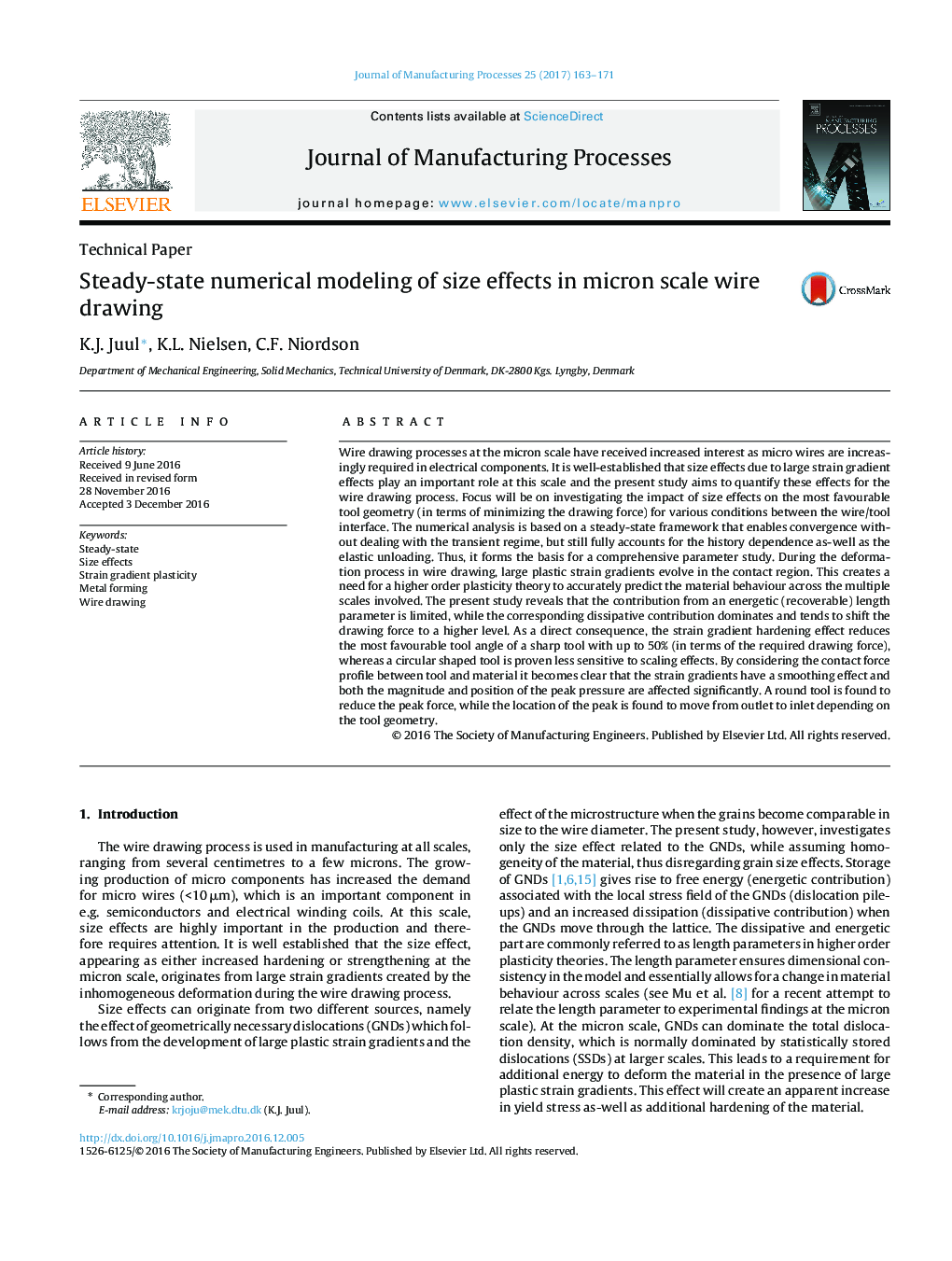| کد مقاله | کد نشریه | سال انتشار | مقاله انگلیسی | نسخه تمام متن |
|---|---|---|---|---|
| 5469375 | 1519231 | 2017 | 9 صفحه PDF | دانلود رایگان |
عنوان انگلیسی مقاله ISI
Steady-state numerical modeling of size effects in micron scale wire drawing
ترجمه فارسی عنوان
مدلسازی عددی حالت ثابت در اثر اندازه در مقیاس سیمان در میکرون
دانلود مقاله + سفارش ترجمه
دانلود مقاله ISI انگلیسی
رایگان برای ایرانیان
کلمات کلیدی
حالت پایدار، اثرات اندازه، انعطاف پذیری شیب تشکیل فلز طراحی سیم،
ترجمه چکیده
فرایندهای طراحی سیم در مقیاس میکرون، افزایش یافته اند، زیرا سیم های میکرو به طور فزاینده ای در قطعات الکتریکی مورد نیاز هستند. به خوبی ثابت شده است که اثرات اندازه به علت اثرات بزرگنمایی کرنش نقش مهمی را در این مقیاس بازی می کنند و مطالعه حاضر با هدف تعیین این اثرات برای فرآیند طراحی سیم انجام می شود. تمرکز بر بررسی تاثیر تاثیر اندازه بر روی مطلوب ترین هندسه ابزار (از لحاظ به حداقل رساندن نیروی طراحی) برای شرایط مختلف بین رابط سیم / ابزار است. تجزیه و تحلیل عددی مبتنی بر چارچوب یک حالت پایدار است که امکان همگونی را بدون برخورد با رژیم گذرا فراهم می کند، اما همچنان به طور کامل وابستگی تاریخی را به همان اندازه که تخلیه الاستیک را نیز در بر می گیرد، به حساب می آورد. بنابراین، این مبنای مطالعه جامع پارامتر را تشکیل می دهد. در طول فرایند تغییر شکل در طراحی سیم، شیب های بزرگ پلاستیکی پلاستیک در منطقه تماس ایجاد می شود. این نیاز به تئوری پلاستیسیته بالاتر نظم دارد تا به طور دقیق رفتار مادی در مقیاس چندگانه درگیر شود. مطالعه حاضر نشان می دهد که سهم پارامتر طول انرژی (قابل بازیابی) محدود است، در حالیکه سهم پاداش مربوطه غالب است و تمایل دارد نیروی کشش را به سطح بالاتر تغییر دهد. به عنوان یک نتیجه مستقیم، اثر سخت شدن شیب شیب، مطلوب ترین زاویه ابزار یک ابزار تیز با 50٪ (از لحاظ نیروی کشش مورد نیاز) را کاهش می دهد، در حالی که یک ابزار شکل دایره ای کمتر اثبات شده برای اثرات پوسته پوسته شدن است. با در نظر گرفتن مشخصات نیروی تماس بین ابزار و مواد، مشخص می شود که شیب باران دارای یک اثر صاف است و هر دو مقدار و موقعیت فشار پیک به طور قابل توجهی تحت تاثیر قرار می گیرند. ابزار گردشی به منظور کاهش نیروی اوج یافت می شود، در حالی که مکان اوج بر اساس هندسه ابزار حرکت می کند از خروجی به ورودی.
موضوعات مرتبط
مهندسی و علوم پایه
سایر رشته های مهندسی
مهندسی صنعتی و تولید
چکیده انگلیسی
Wire drawing processes at the micron scale have received increased interest as micro wires are increasingly required in electrical components. It is well-established that size effects due to large strain gradient effects play an important role at this scale and the present study aims to quantify these effects for the wire drawing process. Focus will be on investigating the impact of size effects on the most favourable tool geometry (in terms of minimizing the drawing force) for various conditions between the wire/tool interface. The numerical analysis is based on a steady-state framework that enables convergence without dealing with the transient regime, but still fully accounts for the history dependence as-well as the elastic unloading. Thus, it forms the basis for a comprehensive parameter study. During the deformation process in wire drawing, large plastic strain gradients evolve in the contact region. This creates a need for a higher order plasticity theory to accurately predict the material behaviour across the multiple scales involved. The present study reveals that the contribution from an energetic (recoverable) length parameter is limited, while the corresponding dissipative contribution dominates and tends to shift the drawing force to a higher level. As a direct consequence, the strain gradient hardening effect reduces the most favourable tool angle of a sharp tool with up to 50% (in terms of the required drawing force), whereas a circular shaped tool is proven less sensitive to scaling effects. By considering the contact force profile between tool and material it becomes clear that the strain gradients have a smoothing effect and both the magnitude and position of the peak pressure are affected significantly. A round tool is found to reduce the peak force, while the location of the peak is found to move from outlet to inlet depending on the tool geometry.
ناشر
Database: Elsevier - ScienceDirect (ساینس دایرکت)
Journal: Journal of Manufacturing Processes - Volume 25, January 2017, Pages 163-171
Journal: Journal of Manufacturing Processes - Volume 25, January 2017, Pages 163-171
نویسندگان
K.J. Juul, K.L. Nielsen, C.F. Niordson,
